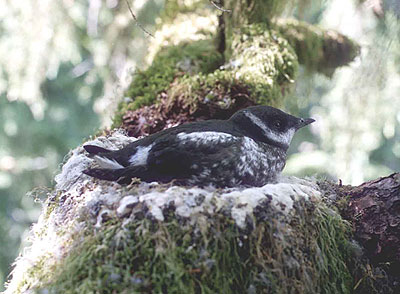Berkeleyan
 |
A juvenile marbled murrelet on its nest platform high in an old-growth Douglas fir. (Tom Hamer photo) |
Murrelet habitat faces threats from industry and government alike
| 08 February 2007
The marbled murrelet, a seabird that nests in old-growth coastal forests, was listed as threatened under the federal Endangered Species Act in 1992. Its numbers severely reduced by extensive habitat reduction (due to logging, increases in the population of jays and ravens that prey on their eggs and chicks, oil spills, and other causes), the bird was listed to grant it some measure of protection while efforts to help restore the population were designed and implemented.| Explaining an endangered species' decline Birth rates for the marbled murrelet - the focus of much conservationist concern - were higher a century ago than they are today, Berkeley researchers find in examining museum specimens |
A murrelet population long viewed as threatened with extinction was suddenly declared to be thriving — despite a status report issued one year earlier that concluded the murrelet faces near-assured extinction within a century even without a reduction in then-current habitat protections. (Casting further doubt on the notion that the Canadian and Alaskan populations are healthy, just this week yet another FWS report indicated that those populations have declined by 70 percent over the last 30 years.)
The 2004 declaration of genetic uniformity emboldened those pressing for reduced protection for the murrelet. Their efforts were given even more support by a recent FWS proposal to remove "redundant" protections from the birds' habitat in Northern California, Oregon, and Washington. According to the FWS, only 221,692 acres out of the 3.9 million currently protected in the murrelet's interest require specific protection not already provided by other laws, forest and habitat-conservation plans, and similar arrangements.
But what the FWS characterizes as a useful tidying-up of duplicative protections is viewed by others as part of a larger strategy less cheerfully devoted to good governmental hygiene.
"The Bush administration has systematically reduced safeguards for threatened species out of what appears to be a desire to increase extractive uses from public lands," asserts Steve Beissinger, a Berkeley professor of conservation biology who has studied the murrelet's habitat for several years (see story above). "Last year, rules governing how the U.S. Forest Service evaluates the impacts of timber harvesting were greatly weakened, and now the agency is no longer required to conserve viable populations of vertebrates and plants." The current FWS proposal to remove more than 3 million acres of old-growth forest from critical-habitat designation for the murrelet, he continues, "opens the potential for harvest in some of these areas."
Conservationists, familiar with these industry strategies from years of trying to protect the spotted owl (which favors inland old-growth rather than the coastal stands crucial to murrelet reproduction), are outraged by the current FWS proposal. Whereas the 2004 decision that reported no genetic variance between scattered murrelet populations was called "a slap in the face of sound science and open, credible decision-making" at the time, opponents' rhetoric has lately become even more pointed and specific.
"In California, this critical-habitat proposal will be the nail in the murrelet's coffin," Scott Greacen of the Environmental Protection Information Center said in a press release issued the day the FWS proposal was made public. Susan Ash, conservation director of the Portland Audubon Society, said at the same time that "the administration is in cahoots with special interests to achieve their logging goals."
The FWS is skeptical about the utility of habitat-conservation plans generally, stating that in almost all cases "recovery of listed species will come through voluntary cooperative partnerships, not regulatory measures such as critical habitat." The agency specifies habitat-protection efforts by state and federal wildlife-refuge managers as useful governmental adjuncts to the "voluntary" and "partnership" arrangements it currently favors.

